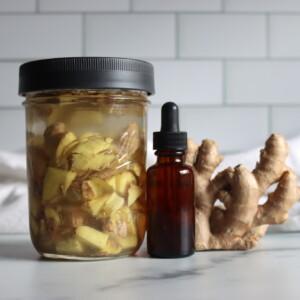
Ginger Tincture
Ginger tincture is a warm, soothing herbal treatment for nausea, indigestion, bloating, gas cramping, morning sickness, and motion sickness.
Equipment
- Dark glass bottles for storage
Ingredients
- Fresh or dried ginger root
- High-proof alcohol vodka, brandy, or rum
Instructions
- If you’re using fresh ginger, start by scrubbing the root well to remove any dirt. You can peel it if you prefer, though it's not necessary. Slice the root into thin pieces or small chunks to increase the surface area, allowing the alcohol to better extract the beneficial compounds. If you’re using dried ginger powder, add it to the jar.
- Pack your mason jar about halfway full with fresh ginger pieces or 1/3 full if you’re using dried ginger. It’s important not to overpack the jar, as the alcohol needs room to circulate and extract the medicinal properties.
- Pour your choice of high-proof alcohol (vodka is common, but brandy or rum will work well too) into the jar, ensuring the ginger root is completely submerged. Add enough alcohol to cover the ginger completely, leaving about an inch of space at the top.
- Tighten the lid securely and give the jar a good shake to mix the ginger with the alcohol. Store the jar in a cool, dark place for 4 to 6 weeks. During this time, the alcohol will slowly extract the ginger’s volatile oils, antioxidants, and anti-inflammatory compounds.
- Every 2 to 3 days, gently shake the jar to help agitate the ingredients and encourage the extraction process. If you notice that the ginger root has floated above the alcohol, top off the jar with more alcohol to ensure the root remains submerged.
- After 4 to 6 weeks, it’s time to strain the tincture. Set up a funnel lined with cheesecloth or use a fine mesh strainer to filter the liquid into a clean container or dark glass bottles. Press the ginger to extract as much of the liquid as possible. You may want to strain the tincture twice if you prefer a clearer liquid.
- Transfer the strained tincture into dark glass storage bottles. Be sure to label the bottles with the contents, the date it was made, and any dosage information. Store your ginger tincture in a cool, dry location, away from direct sunlight.
Notes
Uses
Ginger tincture is a versatile and convenient herbal remedy that can be used both internally and externally. Here are a few common uses: For Digestive Support: Ginger is well-known for its ability to soothe the stomach and aid in digestion. For Inflammation and Pain Relief: The anti-inflammatory compounds in ginger make it a great option for supporting joint health and reducing pain. For Respiratory Health: Ginger’s warming and circulatory-stimulating properties make it beneficial for respiratory health. For Circulation and Energy: Ginger is also known to boost circulation and increase energy levels.Alcohol-Free Option: Ginger Glycerite Tincture
If you prefer an alcohol-free tincture, you can make a glycerite tincture using vegetable glycerin. Here’s how:- For Dried Ginger: Mix 3 parts vegetable glycerin with 1 part distilled water.
- For Fresh Ginger: Use 100% vegetable glycerin (no need for water).
Yield and Storage
Fresh vs. Dried Ginger: If you're using fresh ginger, expect to pull out slightly more tincture than the amount of alcohol you initially added, as fresh root contains moisture. Dried ginger, on the other hand, may absorb some of the alcohol, resulting in slightly less tincture than the amount you started with. Amount of Alcohol: For a quart-sized mason jar, you’ll typically need around 2 to 3 cups of alcohol. For a pint jar, 1 to 1.5 cups should be sufficient. Always make sure the ginger root stays submerged throughout the infusion process. Storage: Ginger tincture can be stored for several years if kept in a cool, dark place. For best results, keep it out of direct sunlight and in an area with stable temperature. Tried this recipe?Let us know how it was!